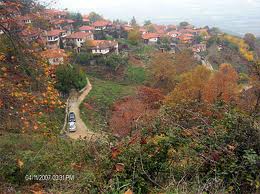In Rapsani, where the gods of ancient Greek mythology used to survey the world, a group of local producers set new standards for the development of the region. The soil - rich in iron schist - the close proximity to the sea and the ideal adaptation of the vineyards to the environment have created superior conditions for the production of the outstanding AOC Rapsani wine.
Rapsani is a small town at the foothills of Mount Olympos, symbol of the Hellenic spirit and freedom, and cultural landmark of Hellenism. Through ancient art, literature and education, Mount Olympos has achieved historical fame extending to our time and has become a symbol of global culture.
The picturesque village of Rapsani
Beside this inimitable monument of nature, Rapsani began its history in the Byzantine era, almost a millennium ago, to which the village’s watermills and church testify. By the 18th century, viticulture and wine production constitute the main agricultural occupation of the people of Rapsani, giving birth to the famous Rapsani wine. Ammi Boué, a French traveller back in 1840, mentions that there are some excellent vineyards in the area of the Tempi valley, and Edward Clarke, an English tourist, writes in 1816 about the wine of Rapsani: "it has the best taste of all the wines of Greece".
The climate
The peaks of Mount Olympos and the neighbouring Aegean Sea form a unique microclimate that is imprinted in the individual character of the Rapsani wine. The influence of the sea and the many hours of sunshine facilitate the ripening of the grapes. Mount Olympos supplies valuable melted ice water and moderates the heat during the summers, permitting a slow development of the grapes, which enriches them with all the elements that constitute the basis for the creation of an exceptional wine.
The soil
The soil consists mainly of iron-rich schist. The iron in the soil is an important quality factor, since it regulates the water capacity of the soil. The soil is poor in organic substances. Its structure enables the penetration of the roots into the sub-soil, so that the vine does not suffer from lack of moisture during the summer. The sub-soil is sandy-clayey. The recesses in the sub-soil date back 40-70 million years. The structure and gradient of the soil guarantee natural drainage of the waters during the rainy periods.
view of the vineyards in Rapsani
the Rapsani vineyards in winter
harvest in Rapsani
The vineyards of Rapsani cover the surrounding hills and count for 100 hectares. They have an eastern-southeastern orientation. Most of the vineyards are located at an altitude of 250 up to 800 metres. This leads to a longer harvest period that begins end of September and lasts for nearly a month.
In 1971, Rapsani was one of the first vine-growing districts of Greece whose wine was acknowledged with the mark of "Appellation of Origin of High Quality". The vineyards are cultivated by 80 vineyardists and managed according to the guidelines of integrated viticulture.
The Rapsani wine very quickly became a synonym of the qualitative renaissance of Greek wine and has won many distinctions and medals at international tastings and competitions.
In Rapsani three indigenous grape varieties are found: Xinomavro, Stavroto & Krassato. In the vineyards, the three grape varieties have traditionally been planted together 1/3 each; only in the last years were the vineyards planted with each grape variety separately.
Xinomavro is the prevailing grape variety in Northern Greece. Its name means sour (xino) and black (mavro) because it gives wines with an austere structure and dark colour. The wine of Xinomavro has a particularly great ageing potential.
Krassato is, as opposed to Xinomavro, cultivated only in Rapsani. It gives alcohol-rich wines of mild acidity and many fast-ripening tannins.
Stavroto is also only cultivated in the Rapsani area. The wine from Stavroto is of average alcohol content, with mild acidity and medium colour. It is quite tannic with fast-maturing tannins.
The blending of the three grape varieties results in a carefully balanced wine. Xinomavro offers its deep red colour and tannin, to help the wine withstand long-term ageing; Krassato balances the acidity and adds to the flavour, while Stavroto contributes towards the character and body of the wine.
Rapsani by Thanos Dougos Winery
Rapsani by George Chrisohoou Winery








No comments:
Post a Comment